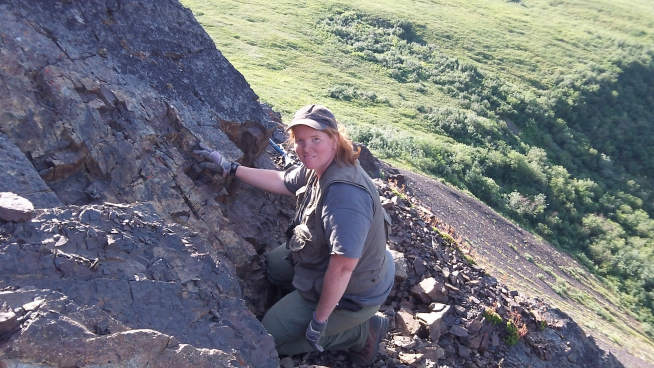ROM Research Colloquium: Kim Tait

Name: Kim Tait
Title: Geology of the Rapid Creek
On February 8th from 9:15am to 6:30pm ROM experts deliver fascinating 15-minute presentations on the latest research in the arts, archaeology and pure and applied sciences. Free (Museum admission not included). Signy & Cléophée Eaton Theatre. Please enter the ROM by the President's Choice School Entrance, located at the south end of the building on Queen’s Park.
What are you going to talk about at the colloquium this year?
At this year’s colloquium I will be talking about our field programme to a remote area of the northern Yukon to study the geology of some unique mineralogical occurrences. We were in the foothills of the Richardson Mountains which is generally a region of rolling tundra rising steadily to the west, cut by many deep river canyons and punctuated by small mountain peaks. It is just over an hour flight in by helicopter out of Inuvik. This seeming proximity to civilization however is an illusion. Once there you are utterly on your own.
The rocks we were interested in are exposed in the canyon walls of the Big Fish River and at Rapid Creek a few kilometres to the west. The canyons are remarkably beautiful as you make your way along the river banks or wade through the river’s shallower reaches. The challenge of working in these twisting river basins is that you may well have to walk (stumble) several kilometres over cobbled ground following the waters serpentine course just to cover a single kilometre as the crow flies. This also means having to ford the rivers any number of times which can be harrowing since the water is generally fast flowing and icy-cold. As well the water often carries a heavy load of sediment making it impossible to see the river bottom which is also paved with cobbles. Despite your best efforts of keeping your balance against the river current and feeling your way with your feet over the unseen slippery boulders, a hip-wader full of water is, unfortunately, not an uncommon experience. It certainly wakes you up. Then, when you’ve reached your destination you climb … and climb … and climb. The rocks you are most interested in are seldom at the bottom of the river bank. The canyons are quite deep and the talus slopes steep. After having stumbled and splashed your way along the river course for an hour or more you may now face another hour (or more) of slogging your way up the talus, carrying your pack and tools. This can be something like walking on marbles while going uphill. As you climb you rapidly discover if you suffer from vertigo. But once you have climbed – crawled, clawed – your way up to the rock face your soggy socks, tired legs, aching back are forgotten as you focus on the intriguing mineralogy. These rock host a variety of rare phosphate-group minerals, many of which were first described from there. The ROM did a great deal of pioneering work in the 1970’s and 80’s describing these new minerals. Such minerals are one of my specialities so I thought it high time that the ROM re-establish a presence at these world famous localities.
How did you first become interested in this topic?
As I mentioned, I am interested in phosphate-group minerals in general. They are a complex, poorly understood group with well over 200 known species. These minerals as you might guess contain the element phosphorus as a major component. How phosphorus behaves – geochemically speaking – in the dynamic rock cycles of the Earth is not well understood either. Phosphate minerals are even to be found in meteorites. So, from the very beginnings of our solar system phosphates have always been there. Phosphorus is of course, a bio-essential element crucial to all life on Earth, so how it is bound up in minerals in nature is important to understand. Unlocking the atomic structure of some of these minerals (how the elements that compose them are put together) can lead to better, more efficient extraction of phosphorus for industry or agriculture and many phosphate-structures have intriguing technological applications. I also have a PhD student working on one of the sub-groups of phosphates found at the Yukon localities. She has already discovered 3 new members of this group. So, it was a rather easy decision to make this trip.
What part of your research do you enjoy the most?
Like many scientists one of the greatest sources of enjoyment is the thrill of discovery: being the first to see something new and being afforded the opportunity to describe and report these discoveries to the world. This makes all the hard work and long hours worthwhile. It also gives me a tremendous sense of satisfaction to mentor and encourage students; to help set them on their own paths of discovery. It makes you feel that you are making a contribution.
